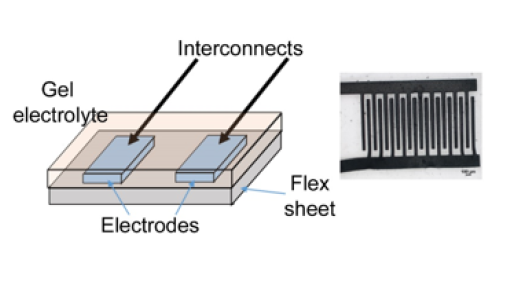New Supercapacitor
Biocompatible Supercapacitors
A flexible and biodegradable electrolyte-based system
Rapid progression in electronics is bringing in an era of new smart and adaptable devices for diverse applications such as wearables, smart surfaces, e-textiles, mobile devices, implants, and epidermal devices. In order to operate in a biological environment, these devices require optimal energy storage and delivery systems. However, current energy storage and delivery devices lack the flexibility and miniaturization required for this environment. Additionally, many of the current energy storage devices are made from toxic electrolytes and harsh fabrication procedures that may not be suitable for these types of applications. Virginia Commonwealth University researchers have developed a novel supercapacitor system that utilizes benign electrolytes, instead of metal or organic solvents, which allows for a biocompatible and biodegradable system.
The technology
The supercapacitor system consists of a flexible protein substrate and at least two electrodes, comprised of a biocompatible conductive ink, pattered onto the protein substrate with a biocompatible gel electrolyte connecting the electrodes. The underlying substrate is comprised of a non-conductive, biocompatible, and degradable silk sheet. This allows the composite to be lightweight and flexible, while being mechanically stable in aqueous environments.
The supercapacitor itself has a high specific capacitance, cycling stability and fast charge rate. This invention presents for the first time, a fully organic supercapacitor for energy storage applications. The novelty of the invention is that it is the first use of biopolymers and conducting polymers to form a fully organic device. Applications of such a device include tissue embodiment, recording in vivo environments, power implantable devices and electronics, bio-sensors
Figure 1. Diagram of Supercapacitor

